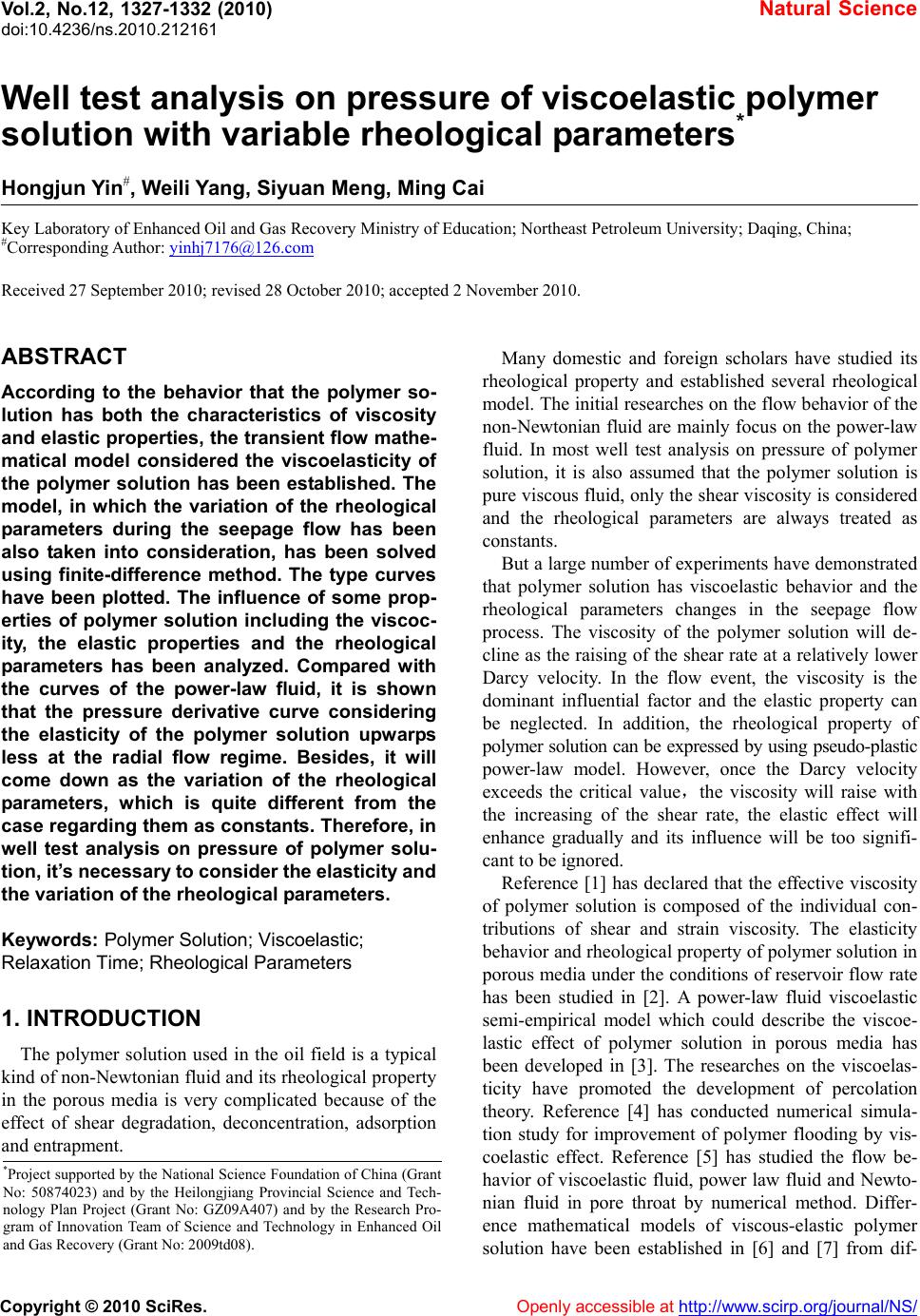
Vol.2, No.12, 1327-1332 (2010)
doi:10.4236/ns.2010.212161
Copyright © 2010 SciRes. Openly accessible at http:// www. scirp.org/journal/NS/
Natural Science
Well test analysis on pressure of viscoelastic polymer
solution with variable rheological parameters*
Hongjun Yin#, Weili Yang, Siyuan Meng, Ming Cai
Key Laboratory of Enhanced Oil and Gas Recovery Ministry of Education; Northeast Petroleum University; Daqing, China;
#Corresponding Author: yinhj7176@126.com
Received 27 September 2010; revised 28 October 2010; accepted 2 November 2010.
ABSTRACT
According to the behavior that the polymer so-
lution has both the characteristics of viscosity
and elastic properties, the transient flow mathe-
matical model considered the viscoelasticity of
the polymer solution has been established. The
model, in which the variation of the rheological
parameters during the seepage flow has been
also taken into consideration, has been solved
using finite-difference method. The type curves
have been plotted. The influence of some prop-
erties of polymer solution including the viscoc-
ity, the elastic properties and the rheological
parameters has been analyzed. Compared with
the curves of the power-law fluid, it is shown
that the pressure derivative curve considering
the elasticity of the polymer solution upwarps
less at the radial flow regime. Besides, it will
come down as the variation of the rheological
parameters, which is quite different from the
case regarding them as constants. Therefore, in
well test analysis on pressure of polymer solu-
tion, it’s nec essary to consider th e elasticit y and
the variation of the rheological parameters.
Keywords: Polymer Solution; Viscoelastic;
Relaxation Time; Rheological Parameters
1. INTRODUCTION
The polymer solution used in the oil field is a typical
kind of non-Newtonian fluid and its rheological property
in the porous media is very complicated because of the
effect of shear degradation, deconcentration, adsorption
and entrapment.
Many domestic and foreign scholars have studied its
rheological property and established several rheological
model. The initial researches on the flow behavior of the
non-Newtonian fluid are mainly focus on the power-law
fluid. In most well test analysis on pressure of polymer
solution, it is also assumed that the polymer solution is
pure viscous fluid, only the shear viscosity is considered
and the rheological parameters are always treated as
constants.
But a large number of experiments have demonstrated
that polymer solution has viscoelastic behavior and the
rheological parameters changes in the seepage flow
process. The viscosity of the polymer solution will de-
cline as the raising of the shear rate at a relatively lower
Darcy velocity. In the flow event, the viscosity is the
dominant influential factor and the elastic property can
be neglected. In addition, the rheological property of
polymer solution can be expressed by using pseudo-plastic
power-law model. However, once the Darcy velocity
exceeds the critical value,the viscosity will raise with
the increasing of the shear rate, the elastic effect will
enhance gradually and its influence will be too signifi-
cant to be ignored.
Reference [1] has declared that the effective viscosity
of polymer solution is composed of the individual con-
tributions of shear and strain viscosity. The elasticity
behavior and rheological property of polymer solution in
porous media under the conditions of reservoir flow rate
has been studied in [2]. A power-law fluid viscoelastic
semi-empirical model which could describe the viscoe-
lastic effect of polymer solution in porous media has
been developed in [3]. The researches on the viscoelas-
ticity have promoted the development of percolation
theory. Reference [4] has conducted numerical simula-
tion study for improvement of polymer flooding by vis-
coelastic effect. Reference [5] has studied the flow be-
havior of viscoelastic fluid, power law fluid and Newto-
nian fluid in pore throat by numerical method. Differ-
ence mathematical models of viscous-elastic polymer
solution have been established in [6] and [7] from dif-
*Project supported by the National Science Foundation of China (Grant
o: 50874023) and by
he Heilongjiang Provincial Science and Tech-
nology Plan Project (Grant No: GZ09A407) and by the Research Pro-
gram of Innovation Team of Science and Technology in Enhanced Oil
and Gas Recovery (Grant No: 2009td08).